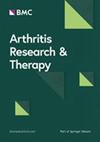系统性硬化症相关间质性肺疾病患者强迫肺活量的变化轨迹
IF 4.9
2区 医学
Q1 Medicine
引用次数: 0
摘要
我们利用SENSCIS和SENSCIS-ON试验的数据评估了长期接受宁替达尼治疗的系统性硬化症相关间质性肺病(SSc-ILD)患者的用力肺活量(FVC)下降情况,以及将患者从安慰剂转为宁替达尼治疗的效果。在SENSCIS试验中,患者被随机分配接受宁替达尼或安慰剂治疗,直到最后一名患者治疗到第52周,但治疗时间不超过100周。在SENSCIS-ON试验(SENSCIS的扩展试验)中,所有患者都接受了开放标签的宁替尼治疗。根据协议,这些试验之间的非治疗期少于 12 周。我们评估了在 SENSCIS 中接受宁替达尼治疗并在 SENSCIS-ON 中继续接受宁替达尼治疗的患者(n = 197)和在 SENSCIS 中接受安慰剂治疗并在 SENSCIS-ON 中开始接受宁替达尼治疗的患者(n = 231)的 FVC 变化轨迹。SENSCIS的最后一次治疗测量和SENSCIS-ON的基线测量被视为锚点测量。在SENSCIS中接受尼替达尼治疗的患者中,SENSCIS中最后一次治疗测量前52周的FVC平均降幅为-41.5 mL,而从基线到SENSCIS-ON第52周的FVC平均降幅为-58.3 mL。在 SENSCIS 中接受安慰剂治疗的患者,在 SENSCIS 最后一次治疗测量之前的 52 周内,FVC 的平均降幅为 - 96.8 mL,而从基线到 SENSCIS-ON 第 52 周(患者接受宁替达尼治疗时)FVC 的平均降幅为 - 42.8 mL。这些研究结果说明了 SSc-ILD 的进展性,并支持宁替尼对长期减缓肺功能下降的疗效。本文章由计算机程序翻译,如有差异,请以英文原文为准。
Trajectories of forced vital capacity in patients with systemic sclerosis-associated interstitial lung disease
We used data from the SENSCIS and SENSCIS-ON trials to assess decline in forced vital capacity (FVC) in patients with systemic sclerosis-associated interstitial lung disease (SSc-ILD) who received long-term treatment with nintedanib and the effect of switching patients from placebo to nintedanib. In the SENSCIS trial, patients were randomised to receive nintedanib or placebo until the last patient reached week 52 but for ≤ 100 weeks. In SENSCIS-ON, the extension to SENSCIS, all patients received open-label nintedanib. Per protocol, the off-treatment period between these trials was ≤ 12 weeks. We assessed the trajectory of FVC in patients who received nintedanib in SENSCIS and continued nintedanib in SENSCIS-ON (n = 197) and in patients who received placebo in SENSCIS and initiated nintedanib in SENSCIS-ON (n = 231). The last on-treatment measurement in SENSCIS and the baseline measurement of SENSCIS-ON were considered anchor measurements. In patients who received nintedanib in SENSCIS, the mean decline in FVC in the 52 weeks prior to the last on-treatment measurement in SENSCIS was − 41.5 mL and the mean decline in FVC from baseline to week 52 of SENSCIS-ON was − 58.3 mL. In patients who received placebo in SENSCIS, the mean decline in FVC in the 52 weeks prior to the last on-treatment measurement in SENSCIS was − 96.8 mL and the mean decline in FVC from baseline to week 52 of SENSCIS-ON (when patients received nintedanib) was − 42.8 mL. These findings illustrate the progressive nature of SSc-ILD and support the efficacy of nintedanib in slowing decline in lung function over the long term.
求助全文
通过发布文献求助,成功后即可免费获取论文全文。
去求助
来源期刊

Arthritis Research & Therapy
RHEUMATOLOGY-
CiteScore
8.60
自引率
2.00%
发文量
261
审稿时长
14 weeks
期刊介绍:
Established in 1999, Arthritis Research and Therapy is an international, open access, peer-reviewed journal, publishing original articles in the area of musculoskeletal research and therapy as well as, reviews, commentaries and reports. A major focus of the journal is on the immunologic processes leading to inflammation, damage and repair as they relate to autoimmune rheumatic and musculoskeletal conditions, and which inform the translation of this knowledge into advances in clinical care. Original basic, translational and clinical research is considered for publication along with results of early and late phase therapeutic trials, especially as they pertain to the underpinning science that informs clinical observations in interventional studies.
 求助内容:
求助内容: 应助结果提醒方式:
应助结果提醒方式:


